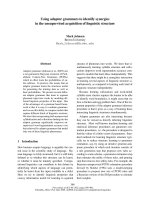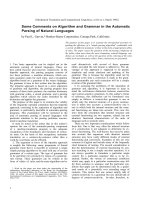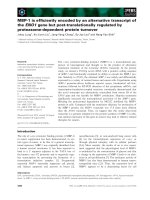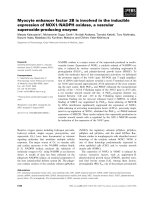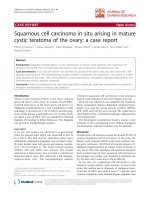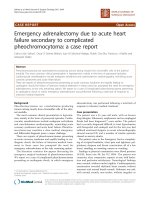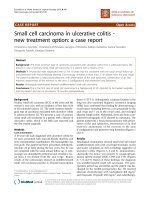báo cáo khoa học: "Squamous cell carcinoma (Marjolin’s ulcer) in an orocutaneous fistula of a large mandibular ameloblastoma: a case report" pptx
Bạn đang xem bản rút gọn của tài liệu. Xem và tải ngay bản đầy đủ của tài liệu tại đây (3.55 MB, 4 trang )
CAS E REP O R T Open Access
Squamous cell carcinoma (Marjolin’s ulcer) in an
orocutaneous fistula of a large mandibular
ameloblastoma: a case report
Peter M Nthumba
Abstract
Introduction: Ameloblastomas are rare lesions constituting 1% of all jaw tumors. Oral squamous cell carcinomas
are common lesions; these constitute about 90% of all oral cancers. Concurrent tumors consisting of
ameloblastoma and squ amous cell carcinoma are extremely rare.
Case presentation: This case report describes a 35-year-old African man who presented with a large mandibular
tumor with an orocutaneous fistula that was found to be an ameloblastoma on histopathological examination,
with concurrent squamo us cell carcinoma histology within the fistula. This presentation was consistent with a
Marjolin’s ulcer within an ameloblastoma.
Conclusion: Ameloblastomas and Marjolin’s ulcers require different management strategies. Careful
histopathological examination of surgical specimens is key to patient outcome, as treatment of these patients
depends on an accurate diagnosis.
Introduction
Ameloblastoma is a benign but locally aggressive odon-
togenic tumor of the mandible and maxilla. It represents
about 1% of all jaw tumors, and 80% of ameloblastomas
occur in the mandible [1]. Ameloblastomas grow slowly
and, if neglected, may grow to enormous sizes, causing
severe facial deformities and functional impairment
[1,2]. Surgical resection with wide margins is the treat-
ment of cho ice [3,4]. Radiological investigations are use-
ful, both as aids to diagnosis and for planning surgery,
an orthopantogram may reveal a “soap bubble” appear-
ance, and an axial computed tomography (CT) scan wil l
reveal the extent of bony and/or soft tissue involvement.
Ameloblastomas may rarely degenerate into ameloblastic
carcinomas.
Squamous cell carcinoma, on the other hand, is the
commonest malignancy of the oral cavity, constituting
about 90% of all oral cancers [5]. Most squamous cell
carcinomas found in the jaws originate from lesions
within the oral cavity; however, primary intra-osseous
carcinoma may arise within the jaw, most li kely
developing from residues of odontogenic epithelium [6].
Surgical excision of resectable lesio ns is the mainstay of
treatment. The simultaneous occurrence of squamous
cell carcinoma and ameloblastoma has previously been
reported [6-9]. Herein the author presents an unusual
case of squamous cell carcinoma that developed in an
orocutaneous fistula through a large ameloblastoma of
the mandible.
Case presentation
A 35-year-old African man presented to the author’s
hospital with a 10-year history of a left mandibular
tumor that had grown gradually over time. The tumor
had ulcerated two years prior to presentation, with a
resultant orocutaneous fistula through which drained
saliva as well as liquids and food particles that he
attempted to ingest (Figure 1), all of which produced a
foul smell. Besides a history of having chewed khat for
most of his adult life, the patient had no other identifi-
able risk factors for oral malignancy.
His physical examination revealed a wasted appearance
with a large, ul cerated left- sided mandibular tumor that
emitted a p urulent, foul-smelling discharge (Figure 1). A
CT scan revealed a large left-sided mandibular tumor
Correspondence:
Plastic, Reconstructive and Hand Unit, AIC Kijabe Hospital, Kijabe 00220,
Kenya
Nthumba Journal of Medical Case Reports 2011, 5:396
/>JOURNAL OF MEDICAL
CASE REPORTS
© 2011 Nthumba; licensee BioMed Central Ltd. This is an Open Access article distributed under the terms of the Creative Commons
Attribution License ( which pe rmits u nrestricted use, distribution, and reproduction in
any medium, provided the original work is properly cited.
extending into the left maxilla and abutting the maxillary
sinus (Figure 2), suggesting that, at most, surgical resection
would be largely palliative. During surgery, a tracheostomy
and a gastrostomy feedin g tube were fashioned to ease
post-operative airway management and nutrition delivery.
Thepresenceofanorocutaneousfistulawasconfirmed.
The tumor was limited to the left side of the hemi-mand-
ible with no maxillary involvement. The tumor was
excised, and the resulting oropharyngeal mucosal and
neck defects were reconstructed by using a left supraclavi-
cular fasciocutaneous flap.
Histopathological examination of the tumor specimen
revealed it to be an ameloblastoma with clear surgical
margins, but it c ontained within it a squamous cell car-
cinoma limited to the orocutaneous fistula (Figures 3
and 4). There was no evidence of tumour in the sub-
mitted neck nodes.
Figure 1 Pre-operative image showing large left tumor with an
orocutaneous fistula through which drained a copious
discharge of saliva as well as liquids and food particles.
Figure 2 Coronal CT scan showing extent of tumor. Arrows
indicate tumor extending into the contralateral mandible and
apparently abutting the maxillary sinus. Neither the right mandible
nor the maxilla was invaded by the tumor. The entire left
hemimandible was involved.
Figure 3 Image showing features consistent with
ameloblastoma (hematoxylin and eosin stain; original
magnification, × 100 magnification).
Figure 4 Image showing squa mous cell carcinoma in ti ssue
from the orocutaneous fistula (hematoxylin and eosin stain;
original magnification, × 200 magnification).
Nthumba Journal of Medical Case Reports 2011, 5:396
/>Page 2 of 4
Post-operatively, the pati ent did well and was offered
left-sided mandibular reconstruction, but he was lost to
follow-up after four months, until he re-presented to
the hospital in health y condition 13 months after sur-
gery, with no evidence of either local recurrence or sys-
temic tumor spread (Figure 5).
Discussion
Tumors may grow to a size that o utstrips their blood
supply, leading to tumor necrosis and ulceration. If the
tumor occurs in an anatomical area with two apposing
epithelialized surfaces such as the oral cavity and skin, it
is feasible that tumor necrosis and ulceration into both
epithelia might lead to the formation of a fistula.
Repeated attempts at epithelialization of the tract, with
constant irritation by saliva, fluids, and oral bacteria,
may lead to malignant degeneration into squamous cell
carcinoma, also known as “Marjolin’sulcer.” Marjolin’s
ulcers occur in scar tissue, classically in burn scars, but
have also been described in numerous other conditions,
including chronic sinuses and fistulas, such as those that
occur in chronic osteomyelitis and urinary fistulas
[10,11]. The fact that squamous cell carcinoma was
found only along the orocutaneous fistula in this patient
provides a strong basis for the hypothesis that chronic
inflammation along the fistula over time led to malig-
nant degeneration and hence to Marjolin’s ulcer (Figure
1). Because of the poor prognosis associated with Marjo-
lin’s ulcers [10,11], the patient was encouraged to return
for regular follow-up visits. His returns for follow-up
were erratic, with no visits recorded between four
months and twelve months post-oper atively. The patient
was noted to have gained weight, with no evidence of
local or dis tant metastasis noted at the thirteen-mo nth
follow-up examination (Figure 5).
Hamakawa et al. [6] reported the case of a pat ient with
a mandibular tumor that, upon histological examination,
was revealed to be both an ameloblastoma and a squa-
mous cell ca rcinoma. Tucker et al. [7] reported the case
of a patient who had simultaneous ameloblastoma and
squamous cell carcinoma in the right and left mandibles,
respectively. Ueta et al. [8] report ed the cas e of a patient
who initially had an ameloblastoma, but after recurrence
and two subsequent resections it was found to have
evolved into a squamous cell carcinoma. The sources of
the squamous cell carcinomas in previous reports of con-
current ameloblastoma and squamous cell carcinoma
have been unclear in previous reports [7,9], while concur-
rent lesions in different sites [6] or tumors that were dis-
covered subsequent to radiotherapy at the same site [9]
have been described in other report s. Tucker et al.[7]
proposed that both lesions in their patient may have
arisen from one sou rce: a radiolucent anterior mandibu-
lar lesion. Table 1 summarizes the demographics of
patients found to have ameloblastoma and a concurrent
or subsequent squamous cell carcinoma [6-9]. The
author believes the present case report to be the first
descrip tion in the English-language literature of a Marjo-
lin’s ulcer within an ameloblastoma.
Figure 5 At the patient’s 13-mont h follow-up exa mination
after undergoing resection, no evidence of local tumor
recurrence was observed, and the patient reported excellent
mastication and oral continence.
Table 1 Demographics of patients reported with simultaneous ameloblastoma and squamous cell carcinoma of the
mandible and/or maxilla
Reference Age,
years
Sex Site Treatment Post-operative follow-up
Hamakawa et
al.[6]
64 F Left mandible Chemotherapy followed by mandibulectomy and neck
dissection
No recurrence at four years
Tucker et al.
[7]
70 M Right and left
mandibles
Unclear Unclear
Ueta et al. [8] 60 F Right mandible Serial excisions leading to right mandibulectomy Lung metastasis at one year
Nishimura et
al.[9]
52 M Left maxilla Radiotherapy for SCC followed by partial maxillectomy
for ameloblastoma
No recurrence at 33 months
Present report 35 M Left mandible Mandibulectomy No recurrence at last visit 13 months
after surgery
Nthumba Journal of Medical Case Reports 2011, 5:396
/>Page 3 of 4
Conclusion
The occurrence of concurrent ameloblastoma and squa-
mous cell carcinoma of the jaws, though previously
reported, is extremely rare. Because the two lesions
require different management strategies, careful histo-
pathological examination of tumor specimens is crucial
to surgical management and ultimately to clinical out-
come. Marjolin’ sulcershavenotbeenpreviously
reported to occur in tumors. This case report indicates
that they can occur and that close follow-up, even in
resource-poor environments, is important, because Mar-
jolin’ s ulcers are generally associated with poor
outcomes.
Consent
Written informed consent was obtained from the patient
for publication of this case report and a ny accompany-
ing images. A copy of the written consent is available
for review by the Editor-in-Chief of this journal.
Acknowledgements
Dr Jerry M Grey, pathologist, is thanked for help with the slides.
Authors’ contributions
PMN came up with the idea for and wrote the manuscript.
Competing interests
The authors declare that they have no competing interests.
Received: 13 August 2010 Accepted: 19 August 2011
Published: 19 August 2011
References
1. Sham E, Leong J, Maher R, Schenberg M, Leung M, Mansour AK:
Mandibular ameloblastoma: clinical experience and literature review.
ANZ J Surg 2009, 79:739-744.
2. Kahairi A, Ahmad RL, Wah Islah L, Norra H: Management of large
mandibular ameloblastoma: a case report and literature reviews. Arch
Orofac Sci 2008, 3:52-55.
3. Chana JS, Chang YM, Wei FC, Shen YF, Chan CP, Lin HN, Tsai CY, Jeng SF:
Segmental mandibulectomy and immediate free fibula
osteoseptocutaneous flap reconstruction with endosteal implants: an
ideal treatment method for mandibular ameloblastoma. Plast Reconstr
Surg 2004, 113:80-87.
4. Sauk JJ, Nikitakis NG, Scheper MA: Are we on the brink of nonsurgical
treatment for ameloblastoma? Oral Surg Oral Med Oral Pathol Oral Radiol
Endod 2010, 110:68-78.
5. Gonsalves WC, Chi AC, Neville BW: Common oral lesions: Part II. Masses
and neoplasia. Am Fam Physician 2007, 75:509-512.
6. Hamakawa H, Kayahara H, Sumida T, Tanioka H: Mandibular intraosseous
carcinoma coexisting with ameloblastoma. J Oral Maxillofac Surg 2000,
58:430-433.
7. Tucker MR, Dechamplain RW, Jarrett JH: Simultaneous occurrence of an
ameloblastoma and a squamous cell carcinoma of the mandible. J Oral
Maxillofac Surg 1984, 42:127.
8. Ueta E, Yoneda K, Ohno A, Osaki T: Intraosseous carcinoma arising from
mandibular ameloblastoma with progressive invasion and pulmonary
metastasis. Int J Oral Maxillofac Surg 1996, 25:370-372.
9. Nishimura T, Nagakura R, Ikeda A, Kita S: Simultaneous occurrence of a
squamous cell carcinoma and an ameloblastoma in the maxilla. J Oral
Maxillofac Surg 2000, 58:1297-1300.
10. Nthumba PM: Marjolin’s ulcers in sub-Saharan Africa. World J Surg 2010,
34:2272-2277.
11. Nthumba PM: Marjolin’s ulcers: theories, prognostic factors and the
peculiarities in spina bifida patients. World J Surg Oncol 2010, 8:108.
doi:10.1186/1752-1947-5-396
Cite this article as: Nthumba: Squamous cell carcinoma (Marjolin’s
ulcer) in an orocutaneous fistula of a large mandibular ameloblastoma:
a case report. Journal of Medical Case Reports 2011 5:396.
Submit your next manuscript to BioMed Central
and take full advantage of:
• Convenient online submission
• Thorough peer review
• No space constraints or color figure charges
• Immediate publication on acceptance
• Inclusion in PubMed, CAS, Scopus and Google Scholar
• Research which is freely available for redistribution
Submit your manuscript at
www.biomedcentral.com/submit
Nthumba Journal of Medical Case Reports 2011, 5:396
/>Page 4 of 4
